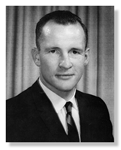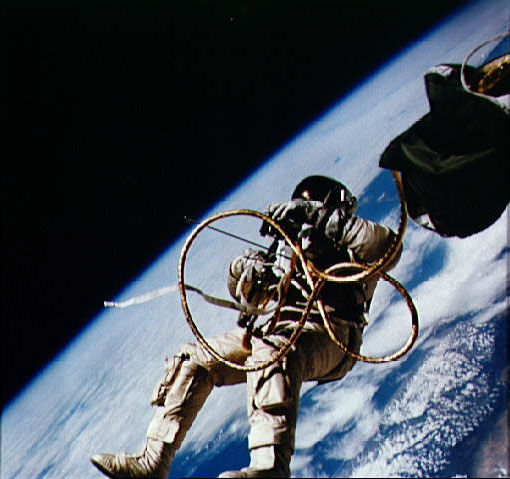- Upon being told it was time for
him to return to the capsule Mission Control and the
whole world listening in on the open audio channel
heard him sigh, "It's the saddest moment of my
life.". The Gemini 4 mission had started the
previous day and would end on 7 June 1965 after a
flight lasting over 4 days, and 62 orbits, three times
the length of the longest previous American space
flight.
-
- Later, upon seeing the pictures
in and on the cover of Life magazine, Omega realized
that White was wearing a Speedmaster prompting them to
re-christen the Omega Speedmaster as the "Omega
Speedmaster Professional" shortly
thereafter...
-
- I'd like to take the
opportunity on this, the 35th anniversary of Ed
White's space walk to personally thank the Astronauts,
support personnel and they're families for their
efforts and sacrifices in regard to the Space
program.
-
- I am confident that Ed White
would have been proud and amazed at the achievements
that Manned spaceflight made in the 10 years following
his spacewalk, However, I believe he would be
disappointed and saddened at how little we have
progressed in the past 25 years... It is my belief
that we should do more to explore space and support
the efforts of those working towards those
ends.
-
- -- Chuck
Maddox
(mailto:cmaddox@xnet.com)
-
-
Wristwatches in Space - A Time Line (through Gemini
4):
-
- 1961 April 12: Yuri
Gagarin becomes the first man in space and the first
to orbit, while wearing a Soviet State-Mandated
Sturmanskije manual-wind 23 Jewel chronograph made
with Omega tooling in the Poljot watch factory. While
these watches were reliable and accurate enough,
Russian cosmonauts later coveted the Omega Speedmaster
worn by their American rivals.
-
- 1962 May 24: Scott
Carpenter wore the first Swiss made watch aboard a
spacecraft when he wore a Breitling Navitimer
Cosmonaut while piloting his Aurora 7 spacecraft for 3
orbits around the earth. He was the fourth American in
space. Note: The first three American astronauts were
given the option to wear a watch and either declined
to do so or the watches that they wore were not
recorded). John Glenn declined to wear a watch, and
Alan Sheppard and Virgil (Gus) Grissom have since
passed away.
-
- 1962 October 3: Wally
Schirra wore an Omega Speedmaster on his Sigma 7
flight which completed 6 orbits of the earth. This was
the first spaceflight for the Speedmaster. There has
been an Omega Speedmaster aboard every American
Spaceflight ever since...
-
- 1963 May 15: Gordon
Cooper flight-tested both an Omega Speedmaster and a
Bulova Accutron Astronaut (First American watch in
space) during his 22 orbit Faith 7 flight. Cooper
would later write "The Omega Speedmaster was selected
by the Mercury Astronauts as a chronograph... it won
over all the competition by a wide
margin".
-
- 1964 September 21:
Donald "Deke" Slayton, director of flight crew
operations, outlined specifications for a flight crew
chronograph in a letter drafted on this date. As a
result six waterproof, shock-proof, anti-magnetic
chronographs were purchased from a Houston Jewelers
(Rolex, Longines, and Omega were the manufacturers of
these chronographs). The end result was the adoption
of the Omega Speedmaster as the offical flight crew
watch for American space missions.
-
- 1965 March 18: Alexei
Leonov performs the first spacewalk during the Soviet
Voskhod 2 mission. It is unknown, but assumed that
while Leonov probably wore a chronograph similar to
the one that Gagarin wore in 1961 inside his
spacesuit, none of the photographs or movies taken of
Leonov's spacewalk show a watch worn outside of the
spacesuit. Note: Leonov later would be a member of the
Apollo-Soyuz Test Flight (ASTP) and wore an Omega
Flightmaster during the ASTP...
-
- 1965 June 4: Ed White
becomes the first American to walk in space with an
Omega Speedmaster ST105.003 (c.321) velcro-strapped to
the outside of his EVA suit. The Omega Speedmaster
becomes the first watch to be worn into outer
space. The photograph on the cover of Life magazine
made the Speedmaster instantly recognizable. "Omega
didn't even know that NASA was using the watch until
they saw that photo" -- James Lovell, Gemini 7 &
12, and Apollo 8 & 13.
-
Sources:
*
TZ Classic 667 states that
" Speedmasters were strapped on both crews of the
American and Russian crew"... This appears to be in error
as Alexei Leonov is pictured in "Time Capsule" book
wearing his Flightmaster during this mission. While it is
possible that Leonov also wore a Speedmaster I
tend to believe the photograph is correct...
Statement
of rights retained and permissions
granted...
Permission is granted for
Damon, Derek Ziglar or RJ to include within the FAQ's
they are writing as long as credit (and a link to this
article) is given and the acknolegement section
(immediately above is included. Permission for personal,
educational or non-commercial use is granted. The author
retains all other rights not specifically mentioned
here...
For all other use please contact
the author.
Disclaimer: Opinions are
my own and knowing me should be taken with a grain or two
of salt...
|

 T
T

